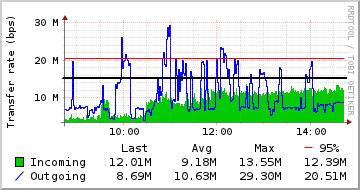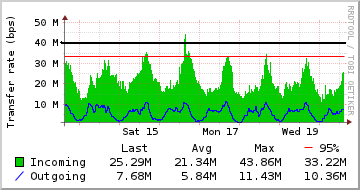What is 95th Percentile, or 'Burstable' Billing?
Mon, 15 Oct 2012
networking
Is it fair to be punished for a successful marketing campaign? The 95th percentile bandwidth model says no: it gives away the top 5% of monthly bandwidth usage completely free. On top of that, the lesser of the inbound and outbound traffic is also completely free. So there are no surprise charges whacked on the monthly bill for having a triumphant spike in traffic.
To calculate 95th percentile or ‘burstable’ billing, data transferred over the network is sampled every 5 minutes, and the average rate both inbound and outbound is calculated for each 5 minute window. The samples are then ranked for inbound and outbound separately, the top 5% of each are discarded, and then the largest of the inbound and outbound traffic is chosen before rounding upwards to the next nearest Mbps. For example:

Red line represents a 95th percentile calculation of 20.51Mbps on this traffic
In this graph the top 5% of traffic is ignored inbound and outbound (separately), leaving 12.39Mbps inbound and 20.51Mbps outbound. The resulting 95th percentile calculation is therefore 20.51Mbps (shown by the red line), rounded upwards to 21Mbps. If the contracted commit was 15Mbps, then there would be a 6Mbps overage due, for example. The black line has been added to show the contractual data commitment.
The above is a very “bursty” unpredictable traffic pattern; most websites and servers follow a weekly “rolling hills” requirement like this:

A more typical bandwidth traffic pattern for website and streaming traffic
Comparing the graphs, we get an idea of how the red 95th percentile line fluctuates depending on the overall usage. The second graph shows usage has peaked over the contractual commitment (in this case 40Mbps) once again. However, the overall 5% calculation on has not been exceeded as the red line remains below the black.
To provide reliable service it’s important for an ISP to ensure sufficient capacity is always reserved for a client’s typical needs. So the commitment is on both sides. A client commits not to exceed the limit for more than 5% of the month, whereas the ISP commits to provide at least the committed limit for 100% of the month.
However, if you use bandwidth higher than your committed data rate for more than 5% of the month, overage charges will begin to be incurred. This is because to support the long term, extra capacity has to be allocated on the network (and in turn upstreams on their networks) to cope with the increased demand being placing on it.
Whatever port speed you have, under normal circumstances, you will be able to connect at that speed to the Internet for as long as you need to. So, with a 100Mbps port, even if you usually push 20Mbps of data, you can still “burst” up to the full 100Mbps – for example, as the result of a successful promotional campaign to drive traffic to your website. This headroom is useful for short-term unpredictable high demand.
Many ISPs, including ConnetU work by the industry standard 95th Percentile Committed Data rate (CDR), which is a statement or “commitment” of how much bandwidth, or data, a client expects to be using most of the time, or more precisely for 95% of the month.
We’re frequently asked how the 95th percentile IP transit model compares with charging per GB of data transfer in the month. The reason for choosing a 95th percentile model is that it ensures your committed speed is always guaranteed so your services will never appear slow provided you stay within your committed data rate (whilst you can burst outside this, additional capacity is not guaranteed though in practise it usually is).
When charging on the GB/month transfer model, an ISP has no idea how that usage will translate into uplink capacities – it could all be used in one day or spread evenly over the course of the month. This makes capacity planning full of guesswork and estimations – a practise ConnetU does not favour over a guaranteed reliable network for clients with sensitive (low latency, low jitter) requirements such as VoIP and streaming.
Since data transfer is a measure of actual usage but the 95th percentile is a measure of required capacity at any instant, it is impossible to convert between the two measurements. 1Mbps 95th Percentile CDR on a 100Mbps port can be as much as 3000GB data transfer per month, depending on traffic patterns and taking into account the 5% of the month (up to 37 hours) in which you are allowed to use the full 100Mbps port speed for data transfer.
Come join us on: